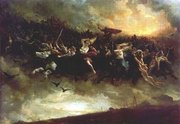Wild Hunt
|
|
The Wild Hunt was a folk myth prevalent in former times across Northern Europe and Britain. The fundamental premise in all instances is the same: a phantasmal group of huntsmen with the accoutrements of hunting, horses, hounds, etc., in mad pursuit across the skies.
Seeing the Wild Hunt was thought to presage some catastrophe such as war or plague, or at best the death of the one who witnessed it. Mortals getting in the path of or following the Hunt could be kidnapped and brought to the land of the dead.
As Kris Kershaw has exhaustively documented (Kershaw 2001), the ritual reenactment of the Wild Hunt was a cultural phenomenon documented among many Gaulish and Germanic peoples. In its Germanic manifestations the Harii painted themselves black to attack their enemies in the darkness. The Heruli, nomadic, ecstatic wolf-warriors, dedicated themselves to Wodan. As humans became more "civilized" and settled (rather than foraging gatherers of the past), these raids by wild men of the forest and marsh counterbalanced the "unnaturalness" of the settled village and city life.
The Norse god Odin in his many forms, astride his eight-legged steed Sleipnir, was deeply associated with the Wild Hunt, particularly in Scandinavia. Odin acquired another aspect (to add to his many other names and attributes) in this context, that of the Wild Huntsman, along with Frigg. The passage of this hunt was also referred to as Odin's Hunt or Asgardareia. In Celtic countries, the Wild Hunt was the hosting of the Sidhe, the fairies; its leaders also varied, but they included Gwydion, Nuada, and Herne the Hunter.
Historical figures known to have participated in the Wild Hunt were St. Guthlac (683-714), and Hereward the Wake (died ca 1070).
The myth of the Wild Hunt has through the ages been modified to accommodate other gods and folk heroes, among them King Arthur and, more recently, in a Dartmoor folk legend, Sir Francis Drake.
In Quebec, the legend of the “chasse-galerie”, or witched canoe, is a favorite.
Compare it to another ghostly troop: the Santa Compaña in Galicia.
See also
External links
- Ari Berk and William Spytma, "Penance, Power, and Pursuit: On the Trail of the Wild Hunt" (http://www.endicott-studio.com/rdrm/forhunt.html)
- Kveldulf Hagen Gundarsson, "The Folklore of the Wild Hunt and the furious host" (http://www.vinland.org/heathen/mt/wildhunt.html) 1992
Reference
- Kris Kershaw, "The One-Eyed God: Odin and the Indo-Germanic Mannerbunde ", Journal of Indo-European Studies 2001de:Wilde Jagd

